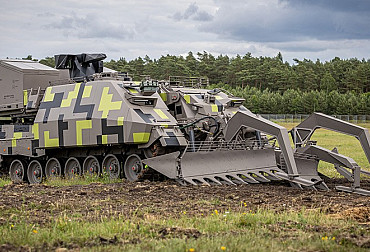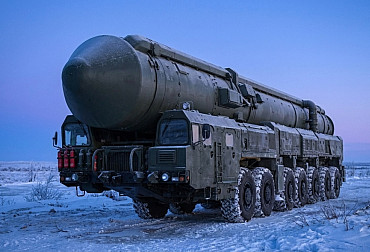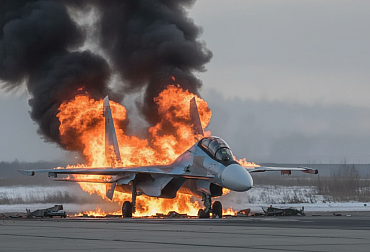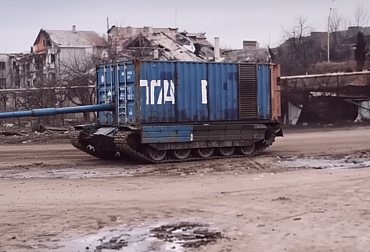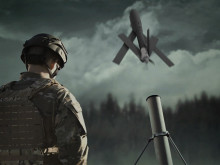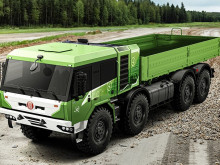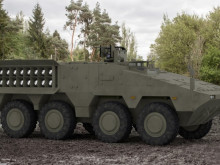Artillery versus drones
The recently signed contract for the supply of Caesar self-propelled guns to the Czech Armed Forces has provoked a range of opinions and reactions among the wider public, both positive and, unfortunately, negative. One can often encounter opinions that the Czech Army should have received a Czech gun, and occasionally one can encounter considerations that the Czech Army should have received a completely different self-propelled gun, e.g. the South Korean K-9 Thunder type. However, there are also opinions questioning the acquisition as such, i.e. the need to replace the obsolete vz. 77 DANA self-propelled howitzers and buy new self-propelled guns - arguing that this is de facto money wasted that could have been spent elsewhere. It is astonishing how many negative reactions the acquisition of a relatively small number of self-propelled guns (only 52 pieces), at a cost of only about CZK 9 billion, has provoked. This is all the more absurd when we consider how large the Czechoslovak artillery was at one time, numbering several thousand guns of various calibers, for which Czechoslovakia paid many times more. One can often even encounter opinions that artillery, including self-propelled artillery, is already obsolete, that it is de facto the technology of past wars, and that the tasks of artillery can be performed by drones. But is this really the case?
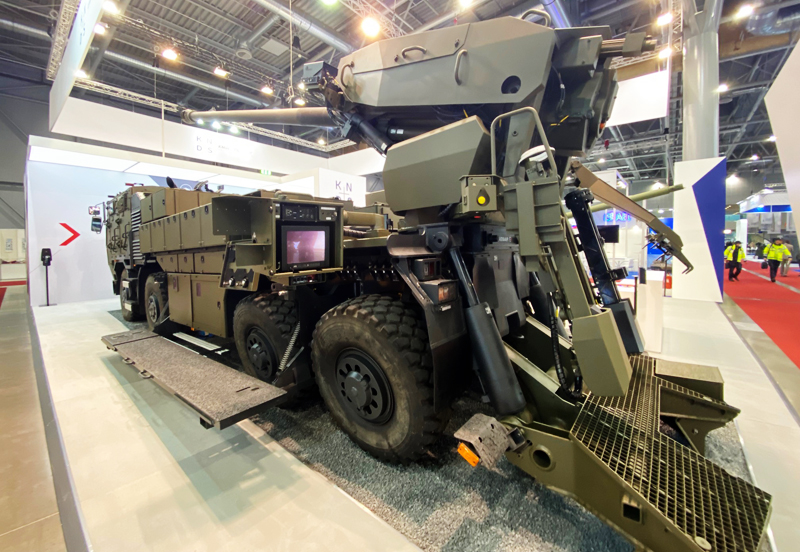 Picture: 155mm ShH CAESAR 8x8 at IDET 2021 | Martin Šiška / CZ Defence
Picture: 155mm ShH CAESAR 8x8 at IDET 2021 | Martin Šiška / CZ Defence
Drones today
Drones are to some extent a fashionable military system today. They are relatively affordable, their numbers are rocketing, and they are well known in the media. But perhaps that is the problem. Because of this media notoriety, we cease to see drones as a technical system and thus lose the ability to realistically assess their true capabilities. This leads to an overestimation, but on the other hand a misunderstanding of their true military potential.
The fact is that drones or Unmanned Aerial Vehicles are playing an increasingly important role on today's battlefield. And all indications are that the importance of drones will continue to grow. Indeed, drones have proven themselves to be versatile systems capable of performing a wide range of tasks, from purely monitoring tasks, to reconnaissance missions, to long-range strikes with weapon systems, making them capable of fulfilling almost strategic weapons roles. Moreover, drones have demonstrated surprising technical robustness and reliability. This is one of the reasons why they are so popular, both among military leaders and the general public.
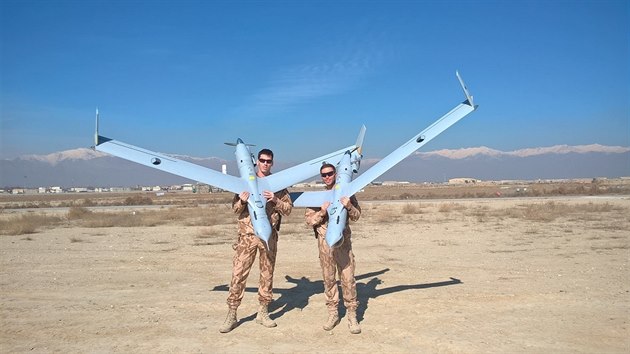
Picture: Drones are to some extent a fashionable military system today. They are relatively affordable, their numbers are skyrocketing, and they are well known in the media. (illustration photo) | Ministry of Defence of the Czech Republic
Another problem is that we often perceive drones, or Unmanned Aerial Vehicles, as just one category of technical systems. However, this is a mistake. In fact, drones represent a wide range of systems, from miniature systems weighing just a few dozen grams and capable of observing their surroundings and thus serving for reconnaissance at the level of an infantry squad, to heavy systems weighing more than 10 tonnes and with a range of several thousand kilometres. It is thus clear that these basic technical parameters alone result in fatal differences between the different types of drones, which thus form a wide range of subcategories. These differences also extend, of course, to the price, which can be tens of dollars for the smallest systems, while the most powerful can reach tens of millions of dollars, approaching the price of supersonic aircraft. It is equally clear that each of these systems, precisely because of their performance but also because of their characteristics, is only suited to a certain type of task - and that it therefore makes little sense to use them for other tasks.
A certain advantage is that drones have already been deployed in several war conflicts and therefore we can analyse their deployment. Drones have been deployed in Syria, and their use in contemporary Ukraine and other countries has been documented. However, perhaps the most attention has been drawn to the deployment of drones during the war between Azerbaijan and Armenia in 2020.
The experience of the war between Armenia and Azerbaijan
The war between Azerbaijan and Armenia is sometimes referred to as the first drone war. Of course, this is not because only drones were used in this war, as virtually the entire forces of both sides were deployed. Nevertheless, the designation is justified. First of all - in this war, drones were indeed used en masse, in the hundreds, and not just in some limited numbers. It is also important that drones were used on both sides, albeit much more so on the Azerbaijani side. Perhaps most importantly, however, the drones have achieved a number of successes in this war. In fact, the records of this conflict show that the Azerbaijani Army's drones have been able to destroy hundreds of the Armenian Army's combat systems - tanks, IFVs, Armoured Personnel Carriers. This is all the more remarkable when one considers that the Armenian Army had a strong air defence system that had been thoughtfully built up over the years (and various images show that it was often these very anti-aircraft systems that were destroyed, both the older 9K33 Osa systems and the powerful S-300 P and other systems).
It is this experience that sometimes leads to a certain overestimation of the importance of drones; to the view that drones can solve all the tasks of the current battlefield, and that classical systems such as tanks, IFVs, but even just self-propelled guns are obsolete. However, such conclusions are completely wrong, and go de facto against the experience of the conflict between Armenia and Azerbaijan.
First of all - it is almost impossible to get any accurate, exact data on this conflict. It would be pointless to rely solely on sources such as YouTube, even if they have their value. Propaganda must also be taken into account; the fact that both sides manipulate figures, exaggerate the losses of the enemy and, on the contrary, downplay the losses of their own armed forces. Yet, if we take all this into account, the most frequently cited and probably the most realistic figure is that the Azerbaijani Army's drones are responsible for about 30% of the enemy's destroyed equipment. In addition, it should be taken into account that the Azerbaijani Army managed to destroy an extremely large amount of Armenian equipment, reportedly more than 40% of its numbers (Armenian drones also had successes, but significantly lower, but this is due to the fact that Armenian drones did not reach the performance of drones that Azerbaijan had). The remainder, i.e. the majority, were then destroyed by conventional, conventional systems - and especially by artillery.
Thus, it was the war between Azerbaijan and Armenia that demonstrated the surprising importance of artillery alongside the importance of unmanned aerial vehicles. Azerbaijan's artillery, along with rocket launchers, proved extremely effective in the conflict, and in some cases was able to completely halt the advance of Armenian troops.
To some extent, this success is understandable. After all, in recent decades Azerbaijan has focused its weapons efforts in the field of artillery. Thus, the Azerbaijani Army has acquired a number of self-propelled guns, including Russian 2S19 MSTA guns, Israeli ATMOS self-propelled howitzers and, last but not least, Czech DANA M1 guns. Similarly, Azerbaijan has also acquired rocket launchers in large numbers, both conventional field rocket launchers of 122 mm calibre and long-range rocket launchers of various calibre (the Russian BM-30 type, but also the Israeli LORA system, etc.). It was these artillery systems, capable of operating at ranges of up to several tens of kilometres, that managed to inflict most of the enemy's losses.
At the same time, it is clear that if the Azerbaijani Army had been oriented only towards drones (as is often described), it would not have acquired these artillery systems. Nor would it have used them so massively - especially in a situation where the loss of these systems, including their crews, may be imminent. Yet, the Azerbaijani military pragmatically went down the path of extensive use of conventional artillery, despite the fact that it could have used its combat drones for the task at hand. Why?
Because the deployment of heavy, strike drones is not as easy as it may seem at first glance. First of all, those heavy, strike drones are relatively expensive. Their cost is less than that of combat aircraft, yet it is very high, reaching millions of dollars. Therefore, even the armies of rich countries can buy a limited number of them. This, of course, leads to armies saving their strike drones and using them only for certain purposes and only against certain targets.
Moreover, drones are not indestructible. Drones can be jammed, or their guidance system can be jammed. And it is in the area of jamming systems that there has been very rapid development recently. Drone manufacturers are already reacting to this, so there is a kind of battle between drones and jamming systems. It is jamming systems that are probably the biggest threat to drones on the battlefield today, although they did not make much of an impact on the Nagorno-Karabakh battlefield (Armenia at the time had mostly only less powerful jamming systems).
Drones can also be shot down by conventional anti-aircraft systems. It is a fact that, for example, the use of the aforementioned Osa anti-aircraft systems (on which the Armenian Army relied most heavily) against drones was unsuccessful, and it was the Osa systems that became a frequent target of drones. On the other hand, for example, the deployment of another Russian system, TOR, against drones has been successful. Moreover, manufacturers of anti-aircraft systems are already responding to the massive use of drones by adapting their products to combat drones as well. In Russia, for example, a new version of the Pancir anti-aircraft system has been developed, which is supposed to be distinguished by its better performance in the fight against drones, and the new Sosna system is supposed to achieve excellent results, etc. Other manufacturers from virtually all countries are following a similar path. Here, too, we can expect a stormy development which will undoubtedly pose another significant danger to drones.
Drones can also be shot down with conventional small calibre guns. Paradoxically, in the Nagorno-Karabakh conflict, the best results were achieved by the seemingly obsolete Zu-23 light guns, which are widely used by dozens of armies or non-state organisations. Similarly old S-60 guns have also achieved several kills. It can be assumed that at least as good or better results could be achieved by Western guns, such as the well-known Bofors 40 mm guns, which also have better ammunition. Of course, for these anti-aircraft guns, as for the aforementioned anti-aircraft systems, the ability to detect such relatively small and fast-moving targets as drones is a major challenge. The fact that these older types of anti-aircraft guns have already been effectively deployed against drones says something.
So it turns out that drones are by no means indestructible. Moreover, it can be assumed that the various armies will rather strengthen their anti-drone capabilities on the basis of the experience of the Nagorno-Karabakh conflict. In such a situation, the question is whether it makes sense to deploy a heavy, powerful (and expensive) combat drone against lesser targets, such as the old T-55 tank. This is a repeat of a similar euphoria after the Gulf War, when, although the missile systems of the time were able to effectively hit their targets with extraordinary accuracy, it soon became clear that it was not very effective to use an anti-surface missile worth hundreds of thousands of dollars on a target such as a mere Technicals vehicle, i.e. a jeep fitted with a large-calibre machine gun, or even the aforementioned T-55 tank.
The above situation thus speaks in favour of the deployment of artillery. What drones can do, an artillery projectile can obviously do, especially if it is a modern powerful 155 mm ammunition. All this is further enhanced by the high performance of today's modern guns, especially the range. Modern self-propelled 155 mm guns (such as the Caesar type) are characterised by their extraordinary range. A range of 40 km is commonly achieved - this is the range of the Caesar. The most modern types of self-propelled guns achieve even higher performance. For example, the upcoming Russian 2S35 self-propelled gun is expected to have a range of 70 km when using special ammunition. The forthcoming US M1299 self-propelled gun has a very similar performance, and ammunition is even being developed for these guns, with which they are expected to have a range of more than 100 km. These guns are also capable of hitting the target in the so-called MRSI mode, when 6-8 shots are fired in very rapid succession. The effectiveness against the target is then at least comparable to a combat drone strike.
Perhaps even higher performance is then achieved by rocket launchers. These can fire at a standard range of 100 km, and in many cases even more (over 200 km). In the case of rocket launchers, it is primarily the ability to engage large area targets that speaks in their favour. This is a capability that has proven itself in modern asymmetric conflicts. Self-propelled guns and rocket launchers are thus capable of performing all the tasks required of them on the modern battlefield.
Another fact speaks in favour of self-propelled guns and rocket launchers. These systems can be protected by anti-aircraft and anti-missile systems. Their effectiveness is not 100%, of course, but they can still prevent a number of attacks (which is why it is important that artillery units also have some anti-aircraft systems as an integral part of the unit). In contrast, UAVs are practically unprotected during their flight. It is therefore possible to destroy them relatively easily. While it is likely that unmanned vehicles will eventually acquire their own active protection system, such systems have not yet been developed, and their deployment is thus music of the distant future.
Self-propelled guns or rocket launchers can therefore perform most of the tasks that drones can perform, but much more efficiently and cheaply. It would therefore be pointless to try to replace self-propelled guns with drones. Indeed, one can put the price of a modern self-propelled gun side by side with the price of a modern combat drone - the sums are roughly comparable. Moreover, it should be taken into account that a self-propelled gun is capable of firing thousands of rounds and can last for decades. The cost of 155 mm ammunition also plays a significant role. The economic factors, then, in the overall context, surprisingly speak not in favour of drones and unmanned aerial vehicles, but precisely in favour of self-propelled guns.
However, it would be wrong to underestimate drones in any way. Drones can only enhance the performance of modern self-propelled guns. After all, it is the experience of the Nagorno-Karabakh war that draws our attention to this factor. Modern guns, capable of firing at a distance of 40-70 km, obviously need some systems to detect targets, observe the effect of fire, etc. - that is, for fire control tasks. To some extent, it is impossible to perform these tasks at such a long distance with conventional systems (this is why the effort to achieve the highest possible range for self-propelled guns is sometimes questioned - see e.g. the article by M. Vasicek "Caesar howitzers: Mere range is not enough"). Using helicopters for these tasks is then often very inefficient. In contrast, drones are ideal for these tasks. In this case, however, it will not be combat, strike drones, but only drones capable of performing observation and monitoring tasks. Such drones can then be less powerful, they can be smaller, lighter - and not least cheaper (which is why it is also easier to accept losses with such drones).
It can be assumed that there will be a division of combat tasks on the battlefield of the future, with heavy, powerful types of strike drones being deployed primarily against important, strategically significant targets. They could thus replace combat aircraft or attack helicopters in these tasks. In contrast, artillery guided by unmanned aerial vehicles will operate against closer, less important targets - with the caveat that this will also involve fighting at considerable distances, probably approaching the 100 km mark.
All this suggests that drones and self-propelled guns are complementing rather than competing with each other. It would therefore be pointless to try to replace one with the other. Especially given that we have only relatively limited experience of deploying drones so far. In the near future, there may also be some fundamentally new combat system that will have an extraordinary ability to destroy unmanned vehicles. No such system has yet emerged, but this does not mean anything, because development in this area is accelerating rapidly, and individual states are investing huge sums in such projects (it must also be borne in mind that development in this area is taking place in a rather secretive mode). Moreover, the history of military technology suggests that technical developments can sometimes take us by surprise.
Moreover, the experience of the Second World War shows that it is a mistake to rely on a 'miracle weapon', on a seemingly universal weapon system capable of performing all tasks (the German approach, but also the Japanese approach). On the contrary, higher performance was achieved by those armies that relied primarily on the best possible synergy of a range of weapon systems, even though these systems had only average performance (with the caveat that it was far from always a case of "many dogs, hare's death"). In addition, one can recall the post-war experience, when for a while it seemed that only rockets could perform all the tasks, and the demise of conventional artillery was prophesied. However, it soon became apparent that conventional artillery systems could still perform a variety of tasks, or could perform them much more cheaply and efficiently than rockets.
Something like this can happen in the case of drones. It would therefore be wrong to see them as some kind of miracle weapon system capable of performing all tasks. Above all, it would be a mistake to dismiss for their sake what has served reliably for decades - namely, self-propelled guns.
















